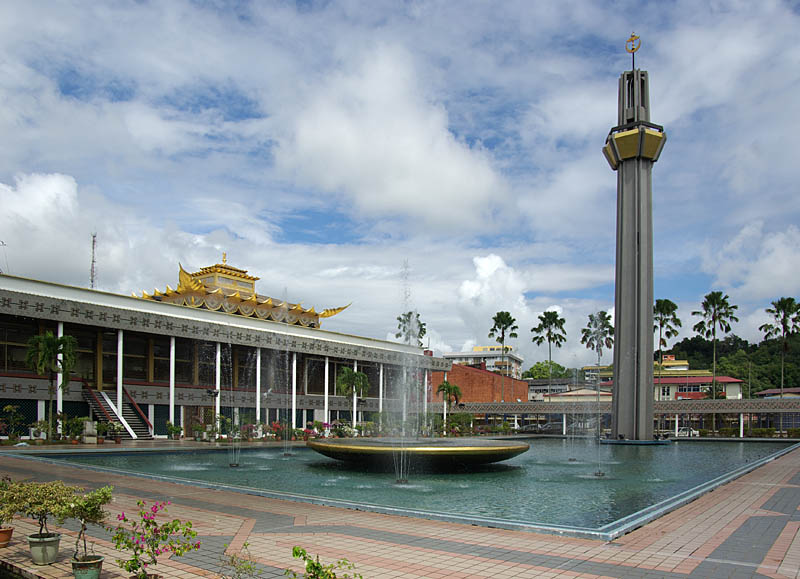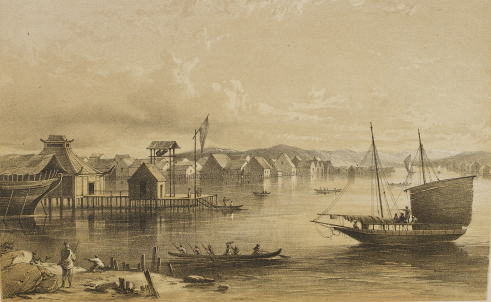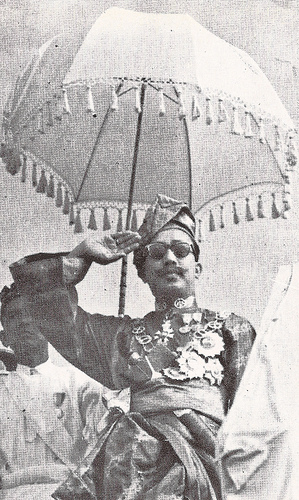|
Lapau
The Lapau, also known as the Royal Ceremonial Hall, is a ceremonial hall in Bandar Seri Begawan, Brunei. It is where the royal ceremonies, state investiture and some state events are traditionally held. It was the place where the present Sultan of Brunei, Sultan Hassanal Bolkiah, was crowned in 1968. Name is historically the type of a Bruneian traditional hall where royal ceremonies and audiences were held. It is believed to have existed since the first Sultan of Brunei, Sultan Muhammad Shah, and since then various buildings had been built over the course of time. Lapau Kajang was the which held the silver jubilee celebration of the ascension to the throne of Sultan Ahmad Tajuddin as the 28th Sultan on 22 September 1949. Location The building is located in Pusat Bandar, the city centre of Bandar Seri Begawan. It is part of the complex which also houses the , the former building of the Legislative Council. Some notable landmarks in its vicinity include the Royal Re ... [...More Info...] [...Related Items...] OR: [Wikipedia] [Google] [Baidu] |
Old Lapau
The Old Lapau ( ms, Lapau Lama), formerly known as the Lapau, is a historical building in Bandar Seri Begawan, Brunei. It was the former or royal ceremonial hall prior to the existence of the current Lapau building. It was also where the Constitution of Brunei was promulgated in 1959. It now houses a museum pertaining to the Constitution. Building The building is located at Jalan James Pearce in Pusat Bandar, the city centre of Bandar Seri Begawan. It is now part of the Brunei History Centre building and adjacent to the Ministry of Home Affairs. The building once served as the , a Bruneian traditional hall where royal ceremonies were held. It was built during the reign of Sultan Omar Ali Saifuddien III, the 28th Sultan of Brunei The sultan of Brunei is the monarchical head of state of Brunei and head of government in his capacity as prime minister of Brunei. Since independence from the British in 1984, only one sultan has reigned, though the royal institution dates ba ... [...More Info...] [...Related Items...] OR: [Wikipedia] [Google] [Baidu] |
Orders, Decorations, And Medals Of Brunei
The orders, decorations, and medals of Brunei consist of (translatable as 'state decorations') and (literally 'medals of honour'). Both are awarded by the Sultan of Brunei on the basis of merit, especially on the contributions to the country. The investiture of some of the state decorations also include the conferment of titles, whereby they become part of the awardees' personal names in official correspondence or when mentioned in formal media in the country. The decorations and medals are under the responsibility of , a government department under the Prime Minister's Office, which also oversees Bruneian royal traditions and protocol. The insignia are displayed in the Royal Regalia Museum located in the capital. Investiture The actual investiture involves awardees being given badges in a ceremony by the Sultan or sometimes the Crown Prince upon the Sultan's discretion. The ceremony is traditionally held in Lapau which is a type of ceremonial hall for royal ceremonies in th ... [...More Info...] [...Related Items...] OR: [Wikipedia] [Google] [Baidu] |
Bandar Seri Begawan
Bandar Seri Begawan (BSB; Jawi: بندر سري بڬاوان; ) is the capital city of Brunei. It is officially a municipal area () with an area of and an estimated population of 100,700 as of 2007. It is part of Brunei-Muara District, the smallest yet most populous district which is home to over 70 per cent of the country's population. It is the country's largest urban centre and nominally the country's only city. The capital is home to Brunei's seat of government, as well as a commercial and cultural centre. It was formerly known as Brunei Town until it was renamed in 1970 in honour of Sultan Omar Ali Saifuddien III, the 28th Sultan of Brunei and the father of the current Sultan Hassanal Bolkiah. The history of Bandar Seri Begawan can be traced back to the establishment of a Malay stilt settlement on the waters of the Brunei River which became the predecessor of Kampong Ayer today. It became the capital of the Bruneian Sultanate from the 16th century onwards, as well a ... [...More Info...] [...Related Items...] OR: [Wikipedia] [Google] [Baidu] |
Booty Edwards & Partners
Booty Edwards & Partners, now known as ''BEP Akitek Sdn Bhd'', is an architectural firm based in Malaysia. Ralph Booty & Sidney James set up their practice in Singapore in 1910 and began the Booty Edwards & Partners firm on September 7, 1923. Ralph Booty had previously operated the firm Ralph Booty and Co. The new firm was first called Booty and Edwards.Arthur Oakley Coltman bought the firm in 1930. It was later called Booty, Edwards & Partners and the firm operated with offices in Colombo, Penang as well as Kuala Lumpur. In 1969 the firm was renamed BEP Akitek Sdn Bhd, the name it still carries. A major event in the firm's early history is when it won an architectural competition for the design of Colombo’s Town Hall and Municipal Offices, held in 1922 The Town Hall remains an imposing landmark in Colombo city. On May 24, 1924, the foundation stone was laid to build this magnificent building to house the Municipal Council of the country's principal city. The firm became a majo ... [...More Info...] [...Related Items...] OR: [Wikipedia] [Google] [Baidu] |
Sultan Omar Ali Saifuddien III
Sultan Sir Omar Ali Saifuddien Sa'adul Khairi Waddien ( Jawi: ; 23 September 1914 – 7 September 1986) was the 28th Sultan of Brunei, reigning from 4 June 1950 until his abdication from the throne on 5 October 1967. He was also Brunei's first Minister of Defence after the country's independence. He was known as "The Architect of Modern Brunei",, "The Royal Poet", and "The Father of Independence". During his reign, 3 chief ministers was appointed according to the Constitution. They were Ibrahim Mohammed Jaafar, Marsal Maun, and Yura Halim. Early life and education Pengiran Muda Omar Ali Saifuddien was born at Istana Kota, Kampong Sultan Lama, Brunei Town on 23 September 1914. He was the second son of Muhammad Jamalul Alam II and Raja Isteri Fatimah. Omar Ali Saifuddien, under the behest of his British mentor and father-figure Sir Roland Evelyn Turnbull, studied at the Malay College Kuala Kangsar (MCKK) in Perak, British Malaya from 1932 to 1936. As a result, he was the fi ... [...More Info...] [...Related Items...] OR: [Wikipedia] [Google] [Baidu] |
Pusat Bandar, Brunei
Pusat Bandar ( Malay for 'City Centre') is the city centre of Bandar Seri Begawan, the capital of Brunei. It is home to a number of national landmarks, important government offices, and commercial and financial establishments. Administration The city centre is part of the municipal area of the capital. It is also one of the administrative villages within Mukim Kianggeh, a mukim of Brunei-Muara District, with a population of 204 in 2016. It has the postcode BA8611. Places The city centre is home to several sites with historical and cultural significance, including: * Omar Ali Saifuddien Mosque, one of the two state mosques of Brunei * , a square where Brunei's independence from the British was proclaimed in 1984 * Yayasan Sultan Haji Hassanal Bolkiah Complex, a landmark commercial centre which overlooks Omar Ali Saifuddien Mosque * Main Post Office () * Lapau, a royal ceremonial hall. It was where the Constitution of Brunei was promulgated in 1959, as well as Hassanal Bolki ... [...More Info...] [...Related Items...] OR: [Wikipedia] [Google] [Baidu] |
Legislative Council Of Brunei
The Legislative Council of Brunei ( Malay: ''Majlis Mesyuarat Negara Brunei''; Jawi: مجليس مشوارت نڬارا بروني; abbrev: Legco) is a national unicameral legislature of Brunei. The council comprises 36 appointed members, that only has consultative tasks. Under Brunei's 1959 constitution, His Majesty Hassanal Bolkiah is the head of state with full executive authority, including emergency powers since 1962. The Council holds its sitting annually in March at Legislative Council Building in Bandar Seri Begawan. History The council was established in 1959 by virtue of Article 23 of Brunei's Constitution of 1959. Its first sitting was held at Lapau on 21 October 1959. In 1984, the Council managed to hold 32 meetings; the last one being the 21st Meeting held on 12 February 1984. Sultan Hassanal Bolkiah dissolved the council on the following day. Hence, legislative powers were fully vested in the Sultan. Brunei had no legislature until 25 September 2004, when the S ... [...More Info...] [...Related Items...] OR: [Wikipedia] [Google] [Baidu] |
Hall
In architecture, a hall is a relatively large space enclosed by a roof and walls. In the Iron Age and early Middle Ages in northern Europe, a mead hall was where a lord and his retainers ate and also slept. Later in the Middle Ages, the great hall was the largest room in castles and large houses, and where the servants usually slept. As more complex house plans developed, the hall remained a large room for dancing and large feasts, often still with servants sleeping there. It was usually immediately inside the main door. In modern British houses, an entrance hall next to the front door remains an indispensable feature, even if it is essentially merely a corridor. Today, the (entrance) hall of a house is the space next to the front door or vestibule leading to the rooms directly and/or indirectly. Where the hall inside the front door of a house is elongated, it may be called a passage, corridor (from Spanish ''corredor'' used in El Escorial and 100 years later in Castle ... [...More Info...] [...Related Items...] OR: [Wikipedia] [Google] [Baidu] |
Musical Ensemble
A musical ensemble, also known as a music group or musical group, is a group of people who perform instrumental and/or vocal music, with the ensemble typically known by a distinct name. Some music ensembles consist solely of instrumentalists, such as the jazz quartet or the orchestra. Other music ensembles consist solely of singers, such as choirs and doo wop groups. In both popular music and classical music, there are ensembles in which both instrumentalists and singers perform, such as the rock band or the Baroque chamber group for basso continuo (harpsichord and cello) and one or more singers. In classical music, trios or quartets either blend the sounds of musical instrument families (such as piano, strings, and wind instruments) or group together instruments from the same instrument family, such as string ensembles (e.g., string quartet) or wind ensembles (e.g., wind quintet). Some ensembles blend the sounds of a variety of instrument families, such as the orche ... [...More Info...] [...Related Items...] OR: [Wikipedia] [Google] [Baidu] |
Gendang Jaga-Jaga
Kendang or Gendang ( jv, ꦏꦼꦤ꧀ꦝꦁ, translit=Kendhang, su, ᮊᮨᮔ᮪ᮓᮀ, translit=Kendang, ban, ᬓᬾᬦ᭄ᬤᬂ, translit=Kendang, Tausug/Bajau Maranao: ''Gandang'', Bugis: ''Gendrang'' and Makassar: ''Gandrang'' or ''Ganrang'' ) is a two-headed drum used by people from the Indonesian Archipelago. Kendang is one of the primary instruments used in the Gamelan ensembles of Javanese, Sundanese, and Balinese, the Kendang ensemble as well as various Kulintang ensembles in Indonesia, Brunei, Malaysia, Singapore, and the Philippines. It is constructed in a variety of ways by different ethnic groups. It is a relation to the Indian mridangam double-headed drum. Overview The typical double-sided membrane drums are known throughout Maritime Southeast Asia and India. One of the oldest image of kendang can be found in ancient temples in Indonesia, especially the ninth century Borobudur and Prambanan temple. Among the Javanese, Sundanese, and Balinese, the has one si ... [...More Info...] [...Related Items...] OR: [Wikipedia] [Google] [Baidu] |
Kampong Kianggeh
Kampong Kianggeh is a neighbourhood in Bandar Seri Begawan, the capital of Brunei. It is also a village in Brunei-Muara District, within Mukim Kianggeh. The population was 1,421 in 2016. It is home to Kianggeh Market, a prominent traditional market in the country. Market Kianggeh Market () is a or local traditional market in Kampong Kianggeh, situated on the banks of Kianggeh River. The market mainly sells produce, fish, meat and local foods. It has existed since the 1960s; it is believed to be the oldest market in the country. The current market complex was built in 2016; it has a total area of , comprises eight buildings and altogether accommodates 313 stalls. The new complex was built as a modern and more organised replacement to the previous facilities. It was reported that the market was originally planned to be relocated to Gadong but scrapped after receiving opposition from the local vendors. Kianggeh Market is regarded as a tourist attraction in Brunei. It was vis ... [...More Info...] [...Related Items...] OR: [Wikipedia] [Google] [Baidu] |
Constitution Of Brunei
The Constitution of Brunei, Brunei Darussalam was created in 1959. Ultimate authority rests with the Sultan of Brunei, Sultan, who is both head of state and head of government. In 2004 the Sultan approved a number of amendments to the constitution, including provision for a partially elected Legislative Council. , elections had not been held. Brunei's political system is governed by the constitution and the national tradition of the Malay Islamic Monarchy (''Melayu Islam Beraja''; MIB). The three components of MIB cover Malay culture, Islamic religion, and the political framework under the monarchy. It has a legal system based on English common law, although Islamic law (''shariah'') supersedes this in some cases. Brunei Legislative Council of Brunei, has a parliament but there are no elections; the last election was held in Brunei Revolt, 1962. Under Brunei's 1959 constitution, His Majesty Hassanal Bolkiah is the head of state with full executive authority. Since Brunei Revolt, 19 ... [...More Info...] [...Related Items...] OR: [Wikipedia] [Google] [Baidu] |




